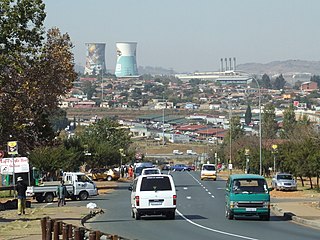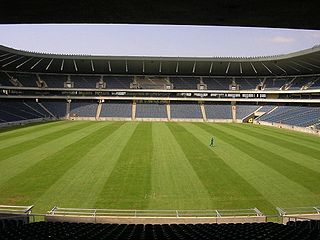
Soweto is a township of the City of Johannesburg Metropolitan Municipality in Gauteng, South Africa, bordering the city's mining belt in the south. Its name is an English syllabic abbreviation for South Western Townships. Formerly a separate municipality, it is now incorporated in the City of Johannesburg Metropolitan Municipality, and one of the suburbs of Johannesburg.

Winnie Madikizela-Mandela, also known as Winnie Mandela, was a South African anti-apartheid activist, convicted kidnapper, politician, and the second wife of Nelson Mandela. She served as a Member of Parliament from 1994 to 2003, and from 2009 until her death, and was a deputy minister of arts and culture from 1994 to 1996. A member of the African National Congress (ANC) political party, she served on the ANC's National Executive Committee and headed its Women's League. Madikizela-Mandela was known to her supporters as the "Mother of the Nation".

Orlando Pirates Football Club is a South African professional football club based in Orlando, Soweto that plays in the top-tier system of Football in South Africa known as DStv Premiership. The team plays its home matches at Orlando Stadium in Soweto.
Alfred Bathini Xuma, OLG, commonly referred to by his initials as AB Xuma, was the first black South African to become a medical doctor, as well as a leader, activist and president-general of the African National Congress (ANC) from 1940 to 1949. He was a member of the African American founded Alpha Phi Alpha fraternity.

The Constitution Hill precinct is the seat of the Constitutional Court of South Africa. It is located in Braamfontein, Johannesburg near the western end of the suburb of Hillbrow. The complex consists of the Constitutional Court, the Old Fort Prison and museum.

First National Bank Stadium or simply FNB Stadium, also known as Soccer City and The Calabash, is an association football (soccer) and Rugby union stadium located in Nasrec, bordering the Soweto area of Johannesburg, South Africa. The site is managed by Stadium Management South Africa (SMSA) and is home of Kaizer Chiefs F.C. in the South African Premier Soccer League as well as the venue for key fixtures for the South Africa national football team.

Benedict Wallet Vilakazi was a South African novelist, linguist, a descendant of the Zulu royal family, and a radically innovative poet who created a combination of traditional and Romantic poetry in the Zulu language. Vilakazi was also a professor at the University of Witwatersrand, where he became the first Black South African to teach University classes to White South Africans. In 1946, Vilakazi also became the first Black South African to receive a PhD.

The Hector Pieterson Museum is a museum located in Orlando West, Soweto, South Africa. Located two blocks away from where student protester Hector Pieterson was shot and killed on 16 June 1976, the museum is named in his honour and covers the events of the anti-Apartheid Soweto Uprising, where more than 170 protesting school children were killed.
Orlando is a township in the urban area of Soweto, South Africa. The township was founded in 1931 and named after Edwin Orlando Leake, mayor of Johannesburg from 1925 to 1926. It is divided in two main areas: Orlando West and Orlando East.

The Soweto uprising was a series of demonstrations and protests led by black school children in South Africa during apartheid that began on the morning of 16 June 1976.

Orlando Stadium is a multi-purpose stadium in Soweto, a township in Johannesburg, in Gauteng province in South Africa. It is the home venue for Orlando Pirates Football Club, a professional soccer team that plays in the Premier Soccer League and owned by the City of Johannesburg.

Desmond Tutu was a South African Anglican bishop and theologian, known for his work as an anti-apartheid and human rights activist. He was Bishop of Johannesburg from 1985 to 1986 and then Archbishop of Cape Town from 1986 to 1996, in both cases being the first Black African to hold the position. Theologically, he sought to fuse ideas from Black theology with African theology.
Zephania Lekoame Mothopeng was a South African political activist and member of the Pan-Africanist Congress (PAC).
Peter Sexford Magubane OMSS was a South African photographer and anti-apartheid activist. He was also the personal photographer of President Nelson Mandela.
Alfred Khumalo, better known as Alf Kumalo, was a South African documentary photographer and photojournalist.

Liliesleaf Farm, also spelt Lilliesleaf and also known simply as Liliesleaf, is a location in northern Johannesburg, South Africa, which is most noted for its use as a safe house for African National Congress (ANC) activists during the apartheid years in the 1960s. In 1963, the South African police raided the farm, arresting more than a dozen ANC leaders and activists, who were then tried and prosecuted during the Rivonia Trial.

Evelyn Ntoko Mase, later named Evelyn Rakeepile, was the first wife of the South African anti-apartheid activist and the future president Nelson Mandela, to whom she was married from 1944 to 1958. Mase was a nurse by profession.

The James Mpanza House is a simple house in Orlando near Johannesburg. James Mpanza was a champion for the rights of black South Africans to have homes. His house was where he and his family lived and it was also a place of public meetings and informal courts.

The Tutu House is a house on Vilakazi Street in Soweto, Johannesburg, South Africa, that was the home to Desmond and Leah Tutu. The house is registered as part of Johannesburg's historical heritage.

The apartheid regime in South Africa began in 1948 and lasted until 1994. It involved a system of institutionalized racial segregation and white supremacy, and placed all political power in the hands of a white minority. Opposition to apartheid manifested in a variety of ways, including boycotts, non-violent protests, and armed resistance. Music played a large role in the movement against apartheid within South Africa, as well as in international opposition to apartheid. The impacts of songs opposing apartheid included raising awareness, generating support for the movement against apartheid, building unity within this movement, and "presenting an alternative vision of culture in a future democratic South Africa."

















